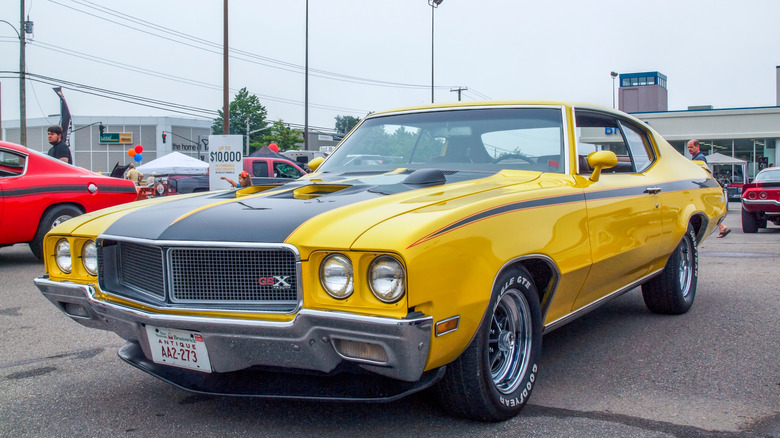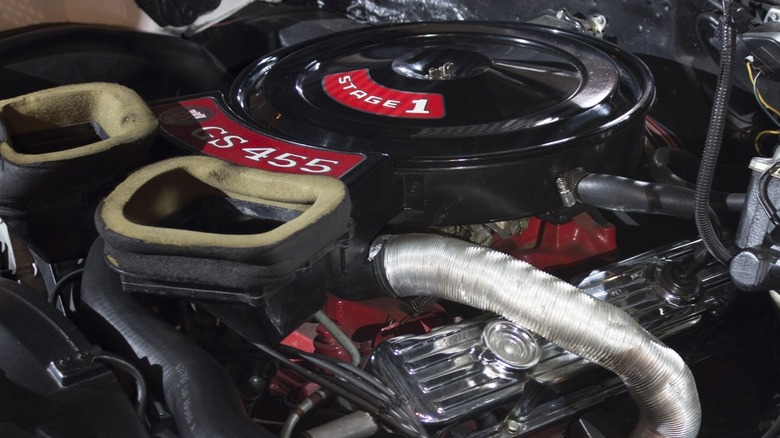1970 Buick GSX Goes Head-To-Head With 1971 Ford Mustang Cobra Jet
The muscle car wars of the 1960s and early '70s were a fascinating time for Americans who loved their cars. Most agree it was all kick-started by the Oldsmobile 88 — the first muscle car — and then things really got heated during the '60s when Ford, General Motors, and Chrysler-owned brands such as Dodge and Plymouth all vied to one-up each other in terms of performance.
The sun must always set on a good day, though, and sadly, it did so on the muscle car's golden era in the 1970s. Multiple factors, such as rising gas and insurance prices, and the implementation of stricter emissions regulations, arrived in the early to mid-1970s and effectively stopped muscle cars in their tracks. Instead, imported Japanese compact cars, like the Honda Accord, became popular at the expense of costly big-block brutes. It was a depressing time for the die-hard gearhead, but fortunately, automakers were able to squeeze in one last swing of the bat before the game was over.
This arrived in the early '70s, before those pesky new regulations were put into place. As a result, these final issues from the muscle car days were some of the most potent we'd seen yet. Among them, we find both the 1970 Buick GSX and '71 Ford Mustang Cobra Jet. Both boasted big-block V8 engines, rear-wheel drive, in excess of 300 horsepower, and all the latest in terms of interior features and "look-at-me" external tweaks. Think big colors, rakish lines, and hood scoops, vents, and spoilers.
Picking between the two back in the day must have been a real head scratcher, and to be honest, it still is today. Here, we strip back the noise, compare specs directly, and see how they fare when pitted directly against one another.
Looking at the stats, it's tough to pick a favorite
There are many facets to consider when picking out a new car these days. It matters how cutting-edge the infotainment systems are, what safety features are included, and just how adjustable, heated, and automated everything is. Wind the clock back 50 years, and so long as it came with a lap belt and windshield wipers, most folks were happy. As a result, when it came to picking out a new muscle car, there was really only one thing that mattered — the muscle.
From this angle, this comparison does have a clear winner, and it proudly displays a Blue Oval badge. The Buick may sport a larger capacity V8, 7.4 liters to the Ford's 7.0, but its output peaks at 360 horses with the Stage 1 pack applied. In the Ford's case, up to 375 horses are on offer, in the case of the strip-ready Super Cobra Jet, which differed from the standard Cobra Jet, giving it a clear advantage on paper.
Off paper, though, the Buick manages to pip the Ford, with period reports claiming a quarter-mile time of 14.28 seconds at 100.5 MPH, with 0 to 60 mph clocked at 6.5 seconds. In comparison, Motor Trend reports that, in period testing, the Ford took 14.7 seconds to master the strip, although it did reach 60 MPH in 6.4, so potentially it's a touch quicker off the line. Neither are what you'd call slow, though, and such differences in quarter-mile times could easily be put down to drivers' reaction times, conditions of the day, tire choices — any excuse you like, really.
Pricing and specification
So, when using performance as a metric to pick the best, it really is like splitting hairs. The Ford is more powerful and marginally quicker off the line, but Buick's GSX will get down a quarter-mile quicker, plus it has a larger engine. Instead, we turn our attention to the specs and pricing of these two legends, including how much they cost when new, and how much one will set you back today.
Specs probably won't help in deciding a clear-cut winner, as both are clearly of the same time, and typically well-specced, so naturally will come heavily loaded with all the features that were up for grabs at the time. For instance, both sport Vinyl-covered sports seats, fat rear tires, spoilers, graphics galore, uprated suspension, and a four-speed manual transmission. How about pricing? The GSX option carried a $1,196 premium above the MSRP for a standard 455 GS, which itself retailed at $3,685, giving us a total figure of $4,881. Pricey, meaning Ford was able to undercut Buick quite significantly, giving the Cobra-Jet Mustang an MSRP of $3,378, broken down as $372 for the engine package, and $3,006 for the base Mustang Fastback price.
In '71 then, opting for the Ford meant you could impress other drivers at stoplights, look great doing it, and keep an extra $1,500 or so in your pocket. Today, though, things are a little different. For the Buick, Hagerty provides two valuations of $66,800 for the GSX and $125,000 for the Stage 1. For the Ford, Hagerty pegs it at $75,300 in the same condition — neatly wedged between the Buick's two valuations. Ultimately, there is no way to pick a best from these two icons; personal taste is the true decider, and for that, there is no wrong decision.

